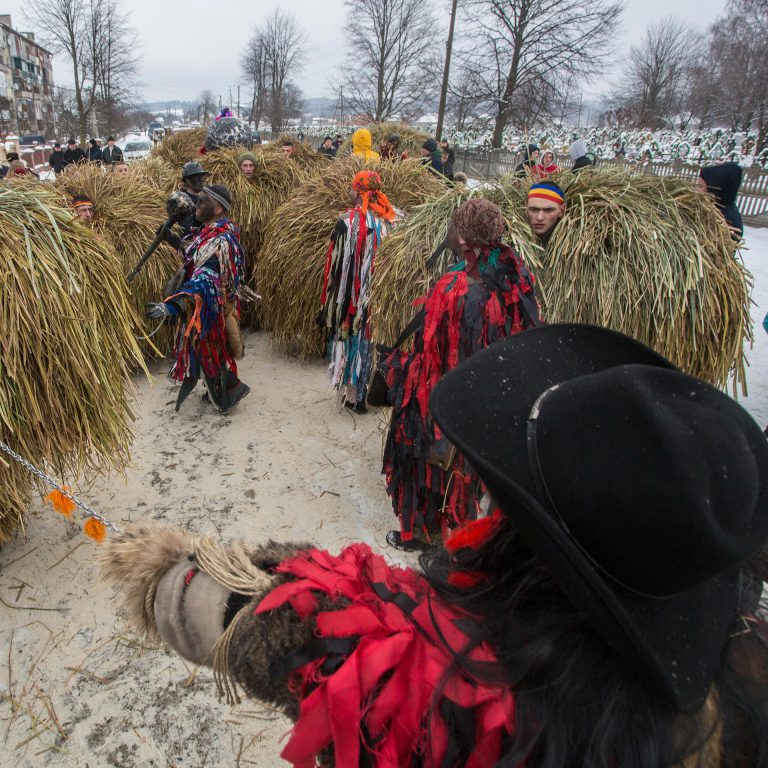Bukovyna is considered to be a region that preserved old customs of Christmas holidays celebration better than anywhere else in Ukraine. Local people call their original Malanka “pereberiya” (pereberiya comes from the Ukrainian word “pereberatys” meaning to change dress, to dress like somebody else), and these carnivals take place in the town of Vashkivtsi and in the villages Krasnoilsk, Horbove, Velykyi Kuchuriv, Boyan, Prypruttia, and Babyn. In Chernivtsi, the main city of Bukovyna, the folk ethnographic festival “Malanka Fest” has taken place since 2011. Every year on the 15th of January, dozens of folk bands come to Chernivtsi to compete in the creativity of their Christmas performances.
The biggest and the most famous Malanka in Bukovyna takes place in the village of Krasnoilsk, on the border with Romania. On the 13th and 14th of January, thousands of people in creative costumes come to the streets of their village with performances, songs, and dances, celebrating the Old New Year (New Year’s Eve according to the Julian calendar, still in use by the Orthodox Church after the calendar change in 1918). The Malanka tradition was preserved here despite the Soviet authorities ban of this celebration, and today thousands of tourists, not just from Ukraine but from all over the world, come to experience this tradition.
New Year according to the Julian calendar
Malanka is observed on the 13th of January according to the Gregorian calendar that came into use starting in 1918. It replaces the Julian calendar, or as it is also called “the old style calendar”, in which Malanka was celebrated on the 31st of December and coincided with the New Year celebration.
The old name of this holiday is Shchedryi Vechir (Bountiful evening), and it got its modern name (Malanka) due to overlapping with the Christian holiday of St. Melania, a nun who lived during the fifth century in the Roman Empire.
The main characters of the celebration in Ukrainian tradition are Melania and Vasyl whose roles were carried out by a girl and a boy. Other characters include Koza (a goat), Zhyd (a Jew), and Likar (a doctor). On this day, people sing special songs called shchedrivky (songs that wish everyone to be bountiful in the new year), greeting the hosts of the house with the New Year and wishing them all the best for the future.
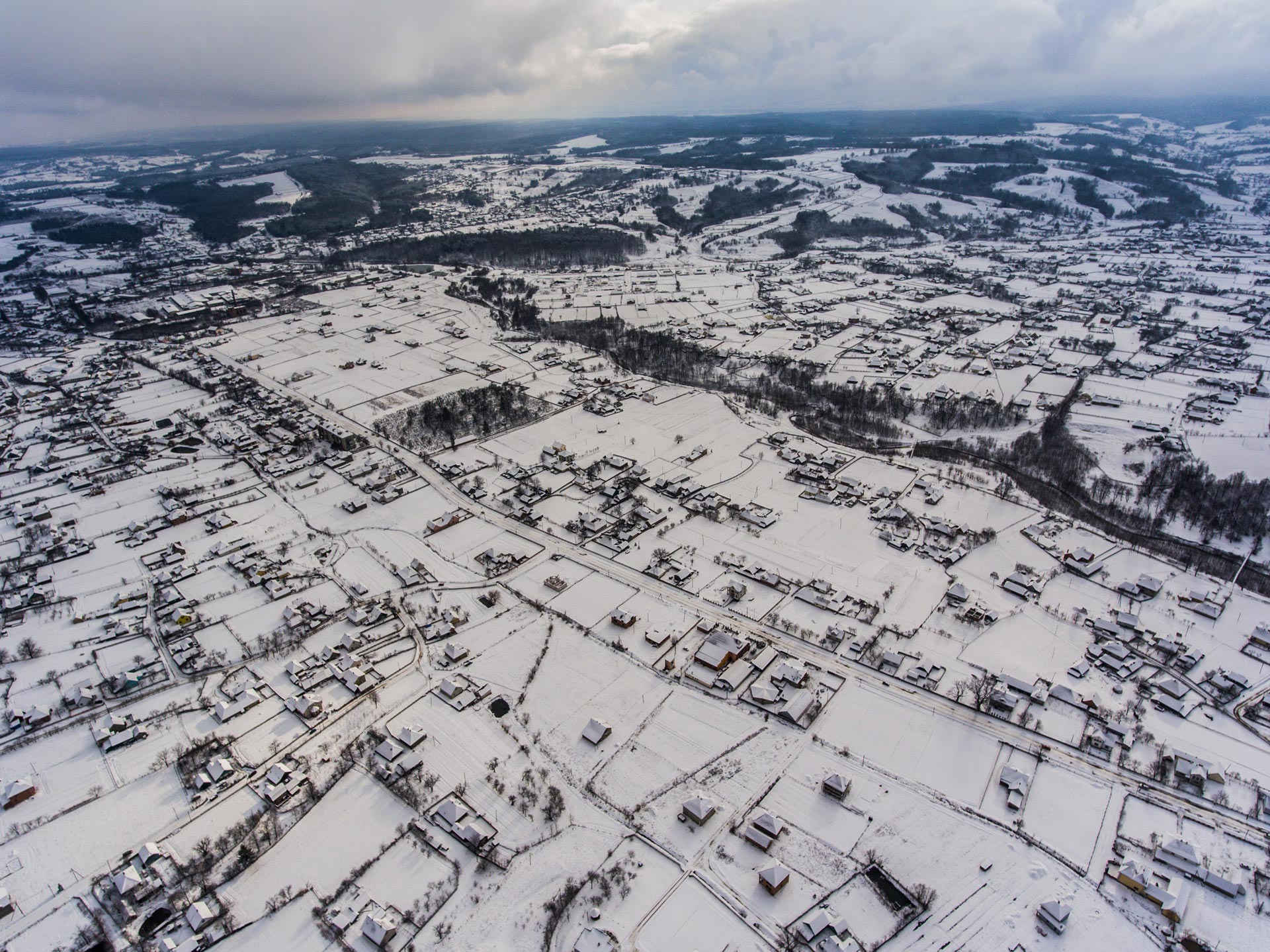
Ninety-five percent of the Krasnoilsk population are ethnic Romanians. They speak mostly Ukrainian or Russian with visitors, while with each other they speak solely Romanian.
In this village, the Malanka celebration traditions have more in common with central European customs rather than with Ukrainian ones. This is one of the reasons why Krasnoilsk Malanka is a unique phenomenon in Ukraine. Another reason is that it is the most important celebration for everyone in the village — everyone is looking forward to it and cherishes the traditions. On the 13th and the 14th of January, the village turns into one big festivity area where everyone is happy to welcome the New Year.
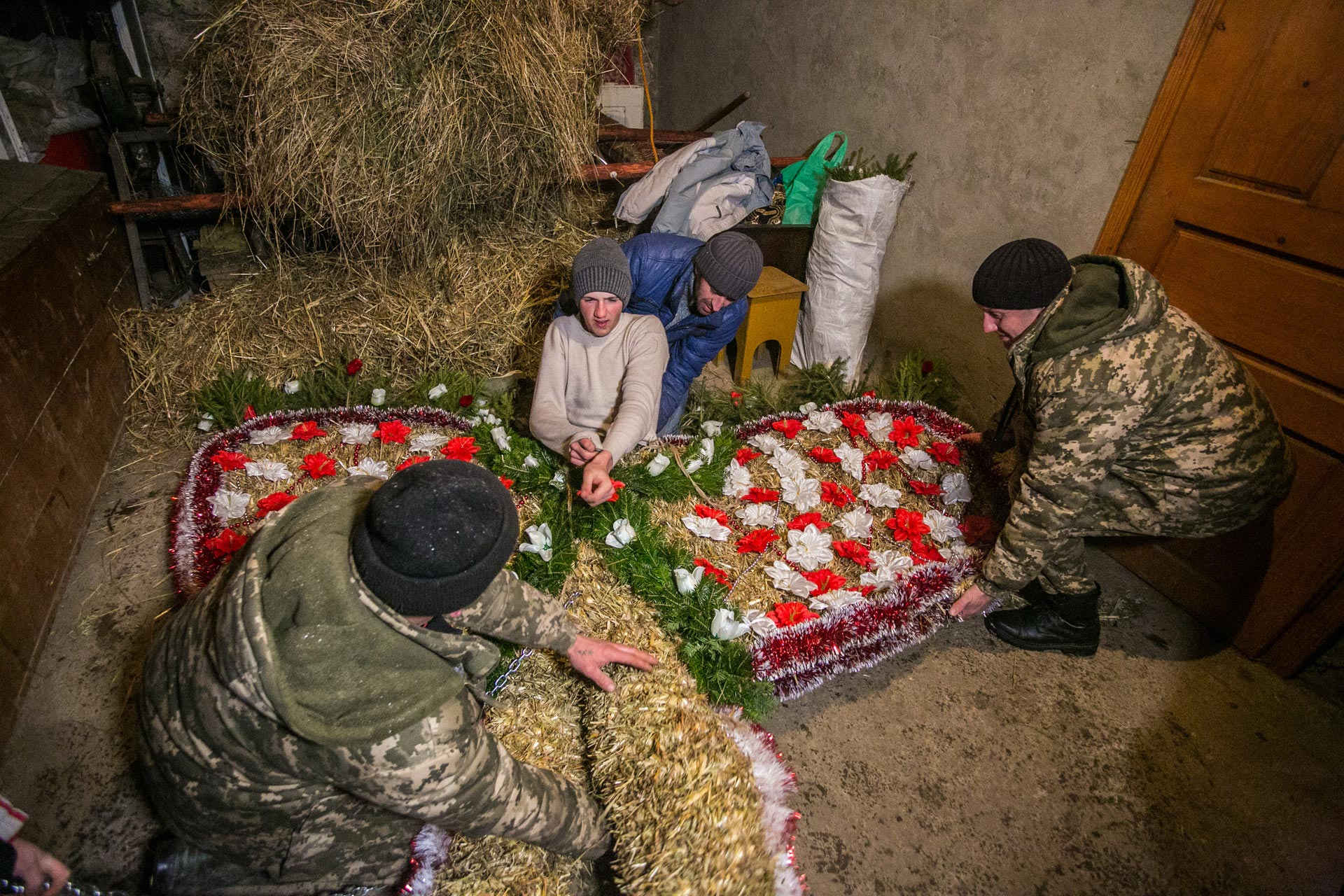
Malanka Characters
The Malanka procession is “men’s business”, only men are involved and the exception is made only for children and teenagers: girls perform roles of queens during the main part of the festival and also often dress into Gypsy ladies walking their young Bears to visit each home on the morning of the 13th of January.
The classic Malanka characters are always the same: any vataha (team of Malanka participants) is headed by Komendant (superintendent), the main organizer of the performance, who gathers people, negotiates with household owners, and stores away the money collected during the festivities.
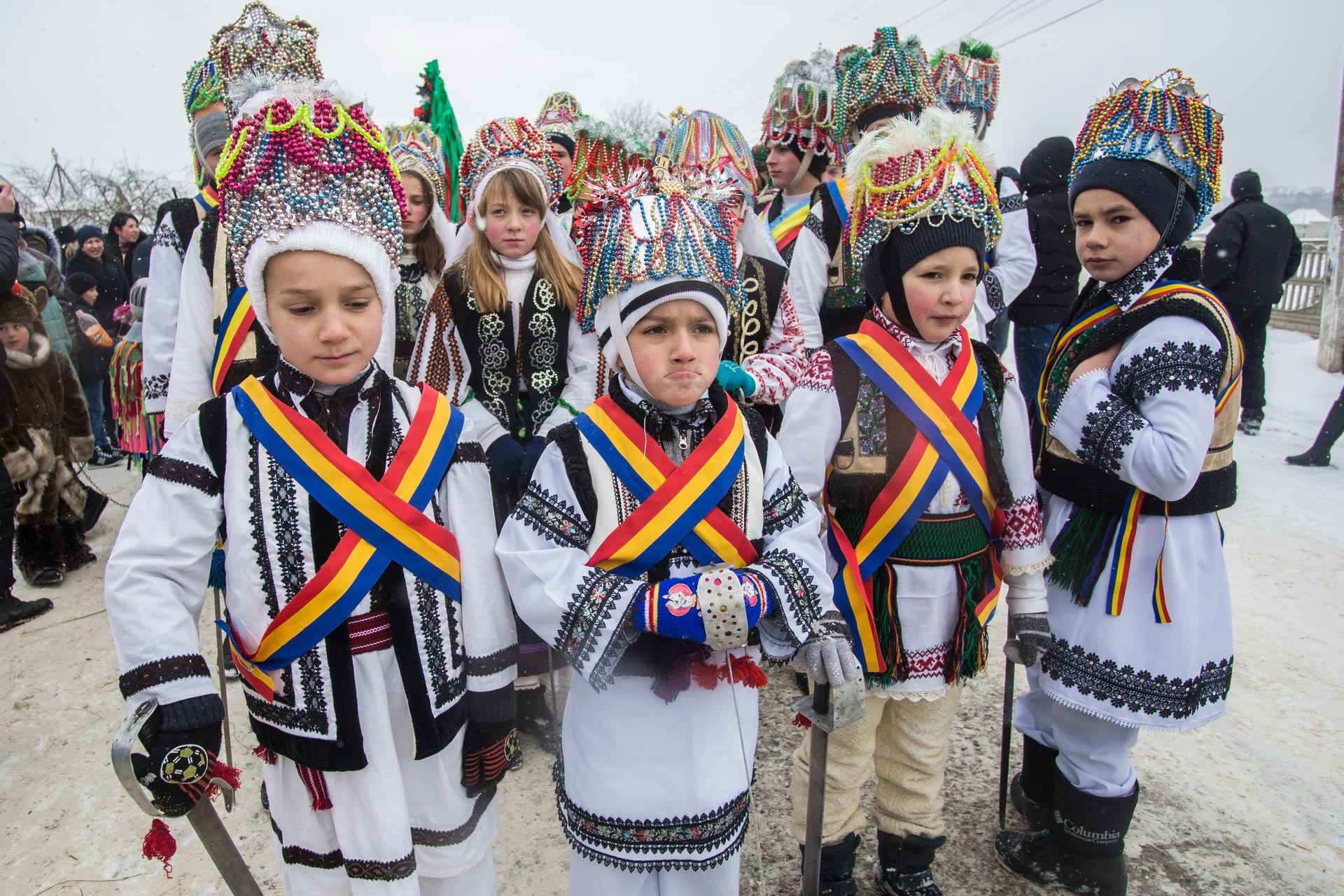
Any Malanka team traditionally consists of Kings and Queens performed by children who are dressed in white costumes decorated with beads. There are also characters wearing masks: stout Did (Grandpa) and Baba (Grandma) in traditional outfits, Likar (Doctor), Zhyd (Gypsy, easily recognizable by a very tall top hat and a big parrot nose), a Gypsy woman with a baby in her arms that will demand alimony from men for “their” child. Sometimes one might see the Horsemen on real or fake horses. According to stories, a couple of decades ago a devil was part of the Malanka team, however, this character disappeared with time in order not to upset local priests.
The brightest characters of the Malanka in Krasnoilsk are undoubtedly the Gypsy and the Bear.
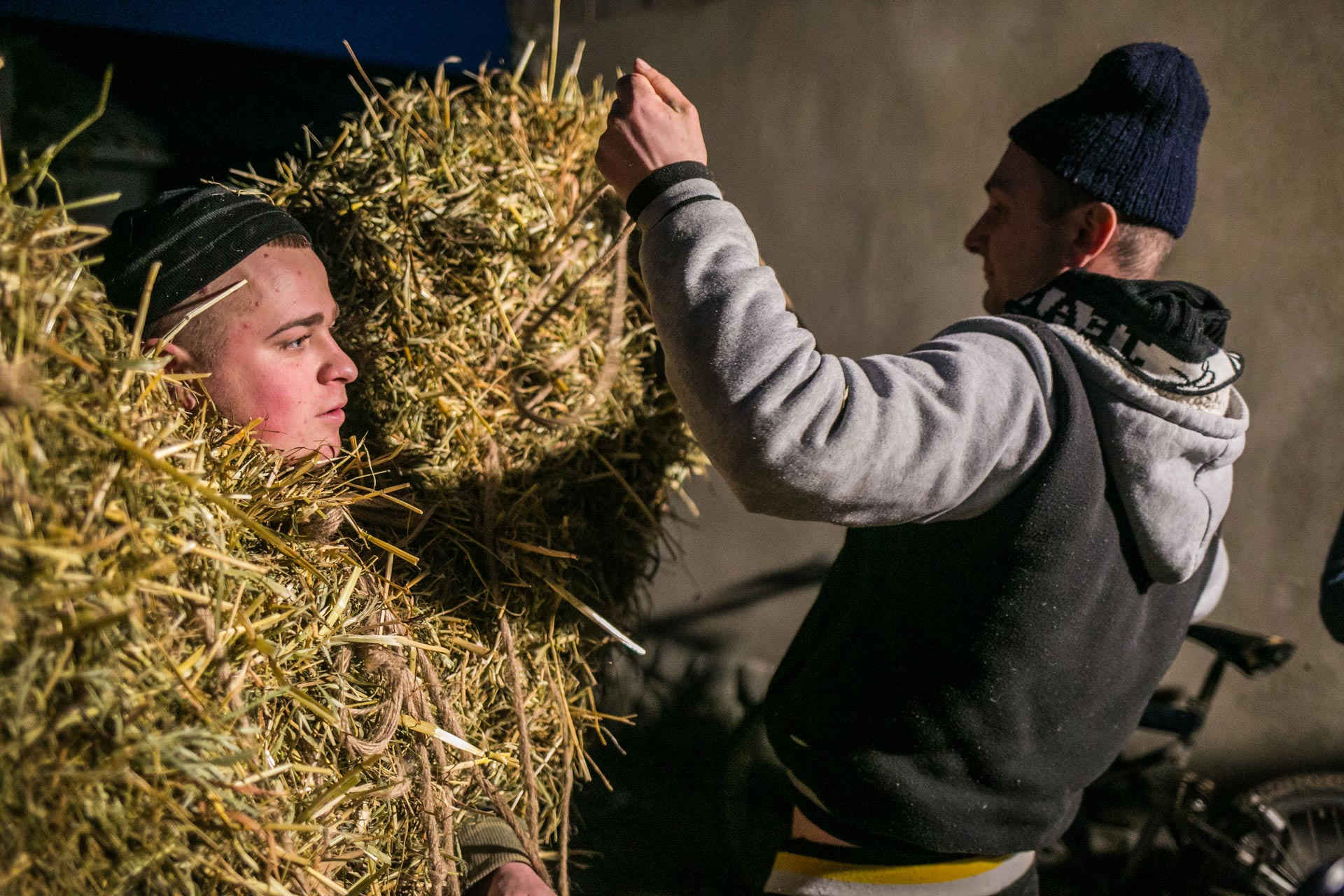
To perform as the Bear is a very honorable and tough, though self-imposed, role. It can be performed only by unmarried young men. The married men that used to dress into the Bear keep participating in Malanka but put on masks of the Grandpa, Grandma, or the Jew.
There are seven “corners”, or village districts, in Krasnoilsk: Putna, Putna din Jhos, Trazhany, Sus, Dial, Huta, and Slatyna, and in each of them the characters of the Gypsy and the Bear have distinctive peculiarities.
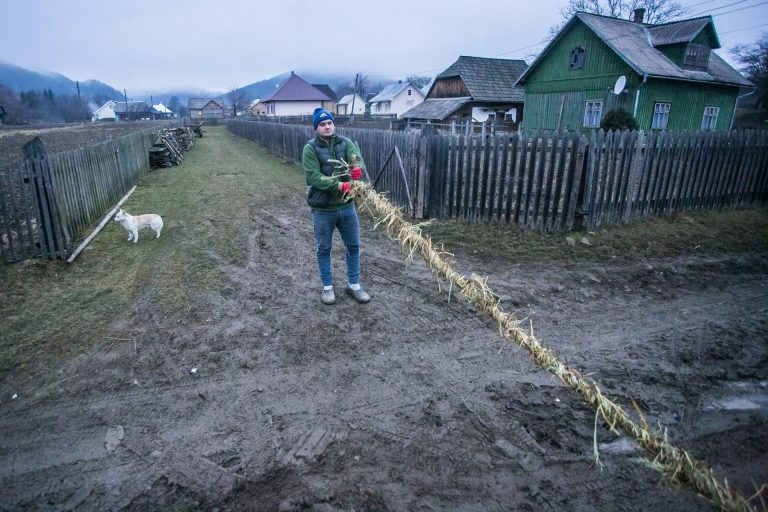
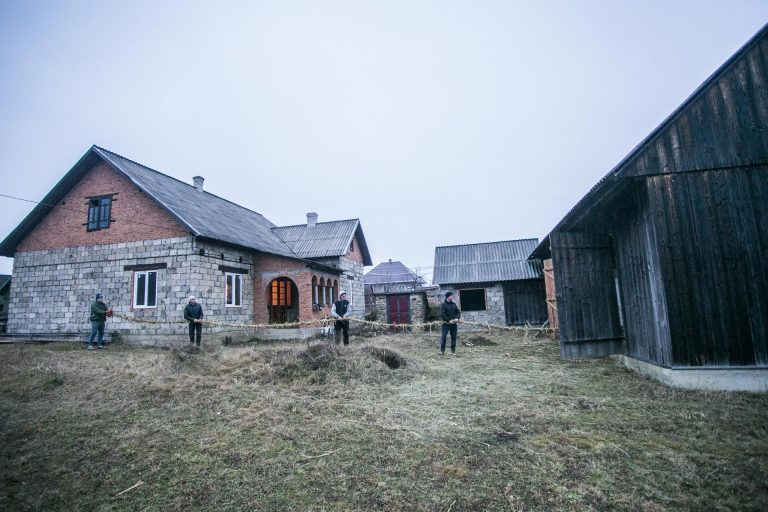
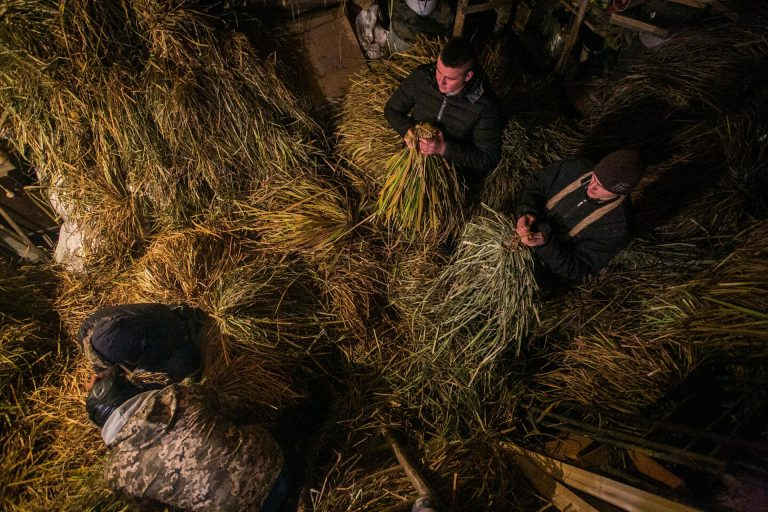
slideshow
The Bear’s costume is made out of hay or straw harvested from the summer and stored especially for this occasion. There are two types of Bears: winged ones and haystack-like ones. The outfit with wing-like shoulders is non-removable and is made out of hay rolled in ropes. A person gets inside such a costume by lying down and wears it during the whole period of celebration.
The haystack costume is made using a sheepskin coat and bunches of straw tied to it. Usually, it weighs less than the wings and can be taken off easily, plus can serve as a chair during breaks.
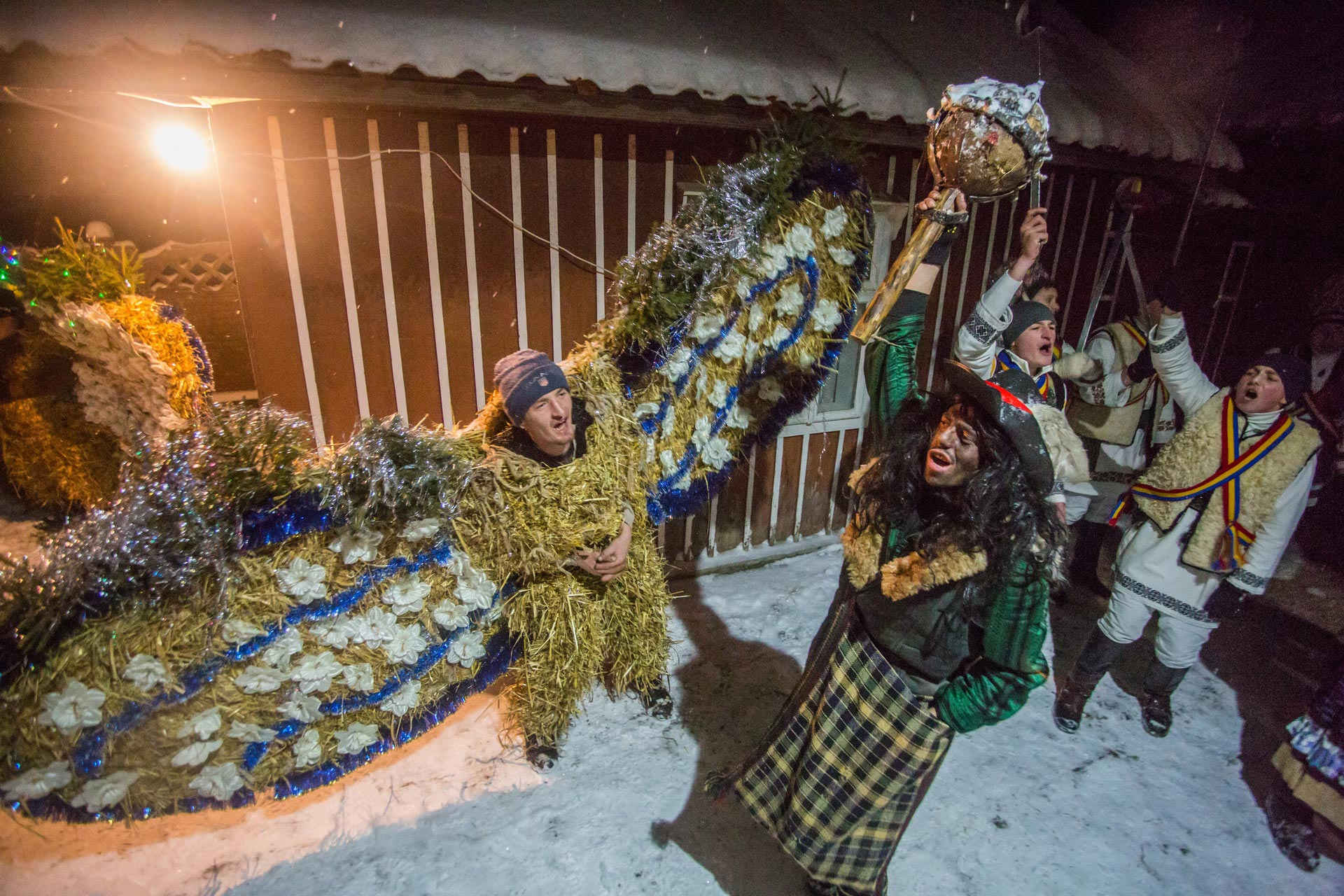
In the district Trazhany, the Bears have the longest wings, and almost every year they get longer: a decade ago their average length was three meters, but today they reach up to six meters. The costume weighs about 50 kilograms. The Gypsies from this district also stand out: they wear red pants and bandanas, with large maces that can be lifted only with both hands.
The “winged” Bears are also common for the districts of Diala and Sus, and it’s easy to distinguish them from other districts’ bears. The Bears from Sus are small, and their wings are heart-shaped with stitched ornaments on their chests: only 15 to 20 costumes like that are made. The Gypsies stand out here too: they wear black cut-off jackets with embroidery and fake karakul hats.
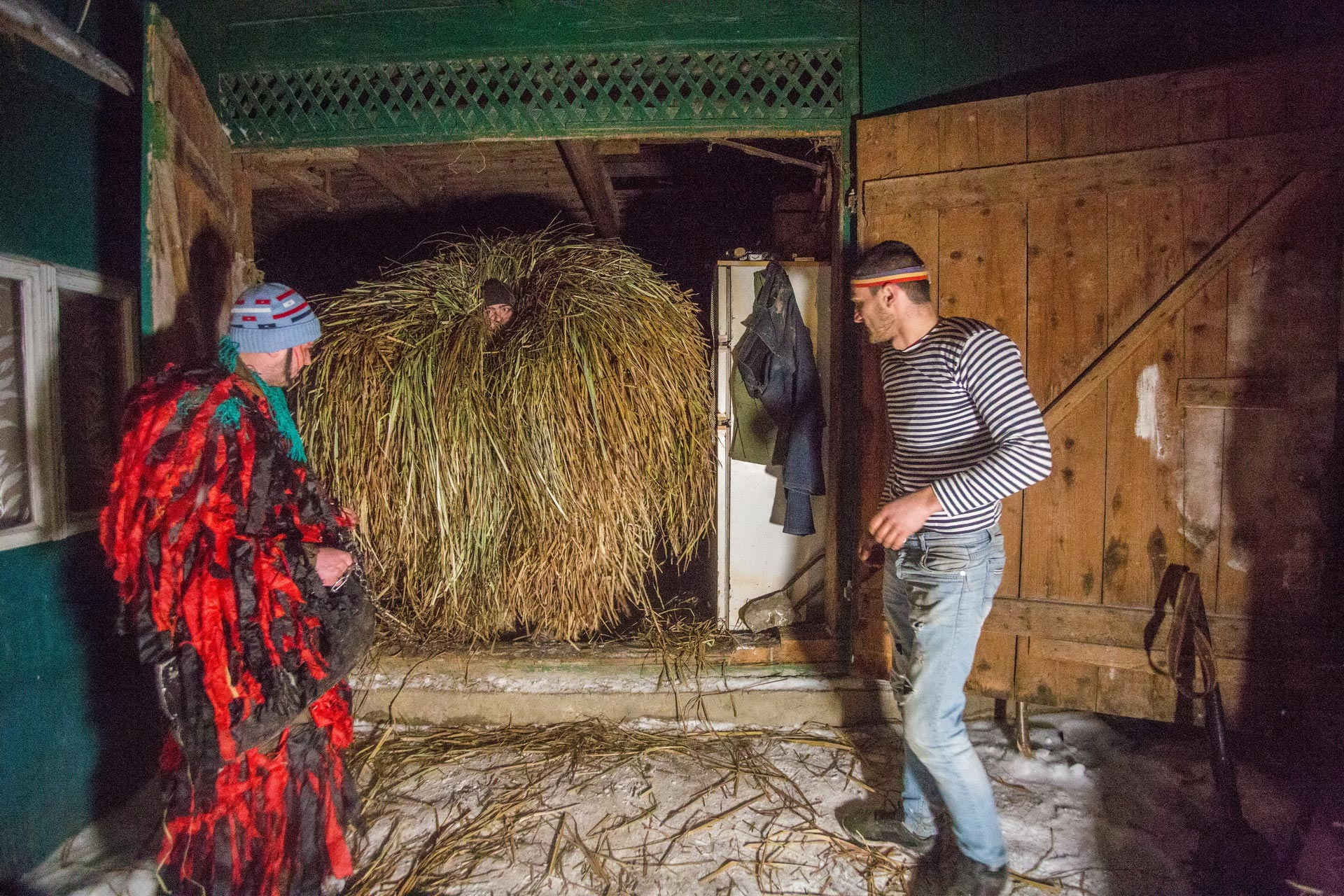
The haystack-like Bears are numerous in Putnia, the second biggest district of Krasnoilsk. They are accompanied by the Gypsies in helmets with horns, smeared with soot and wrapped in animal skins. Apart from the traditional mace for this character, the Gypsies also use axes, sledgehammers, and swords to overmaster the Bears.
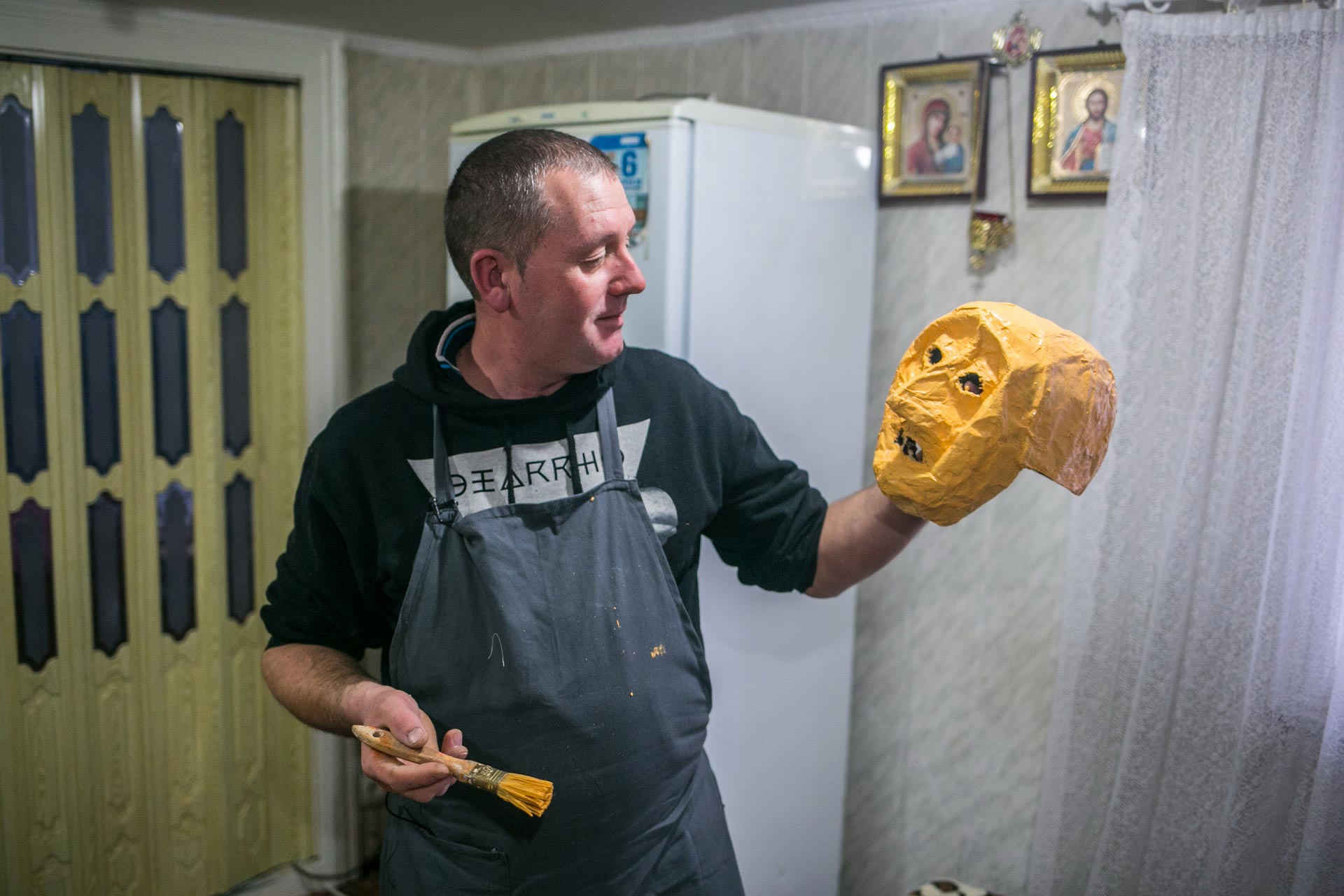
Masks Craftsman
Ivan Tarnovytskyi lives on a hill overlooking the main village street. He has been creating masks for Malanka for over 15 years. He says he fell in love with this craft after the first glance because he loves traditions.
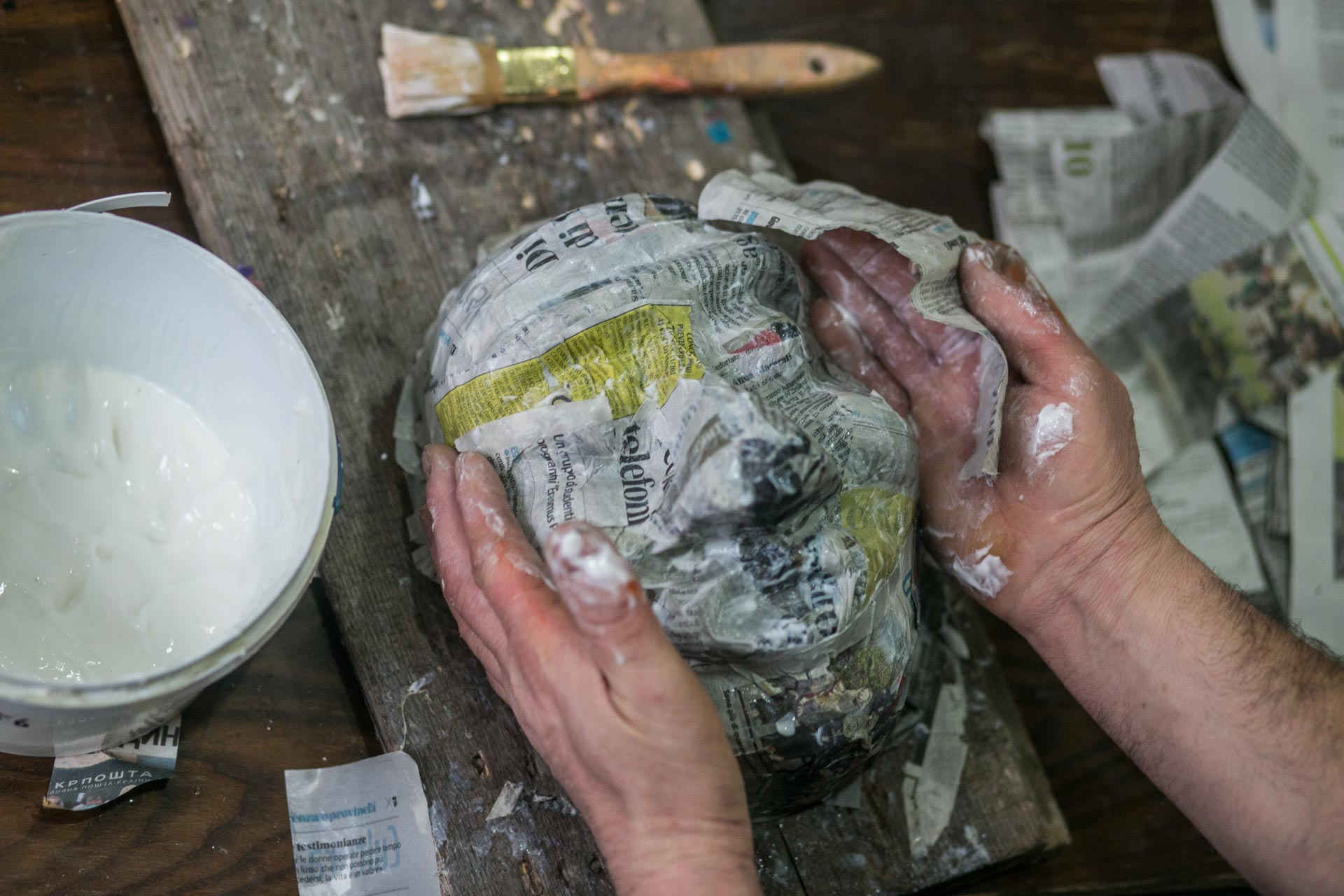
— I haven’t slept for almost a month. During the day I’m at work, and in the evening I work here.
In old times the masks were glued together with flour, the craftsman says, but then they were eaten by mice. That’s why they started to be made with white glue. It takes one liter of glue to make one mask. Ivan is not interested in turning mask making into a business. Once in a while, he sells a mask to an interested passerby for about 150 UAH. Since a liter of glue is about 60 UAH, plus he needs paint, varnish, and some fabric for hats, it turns out he sells the masks for about at cost.
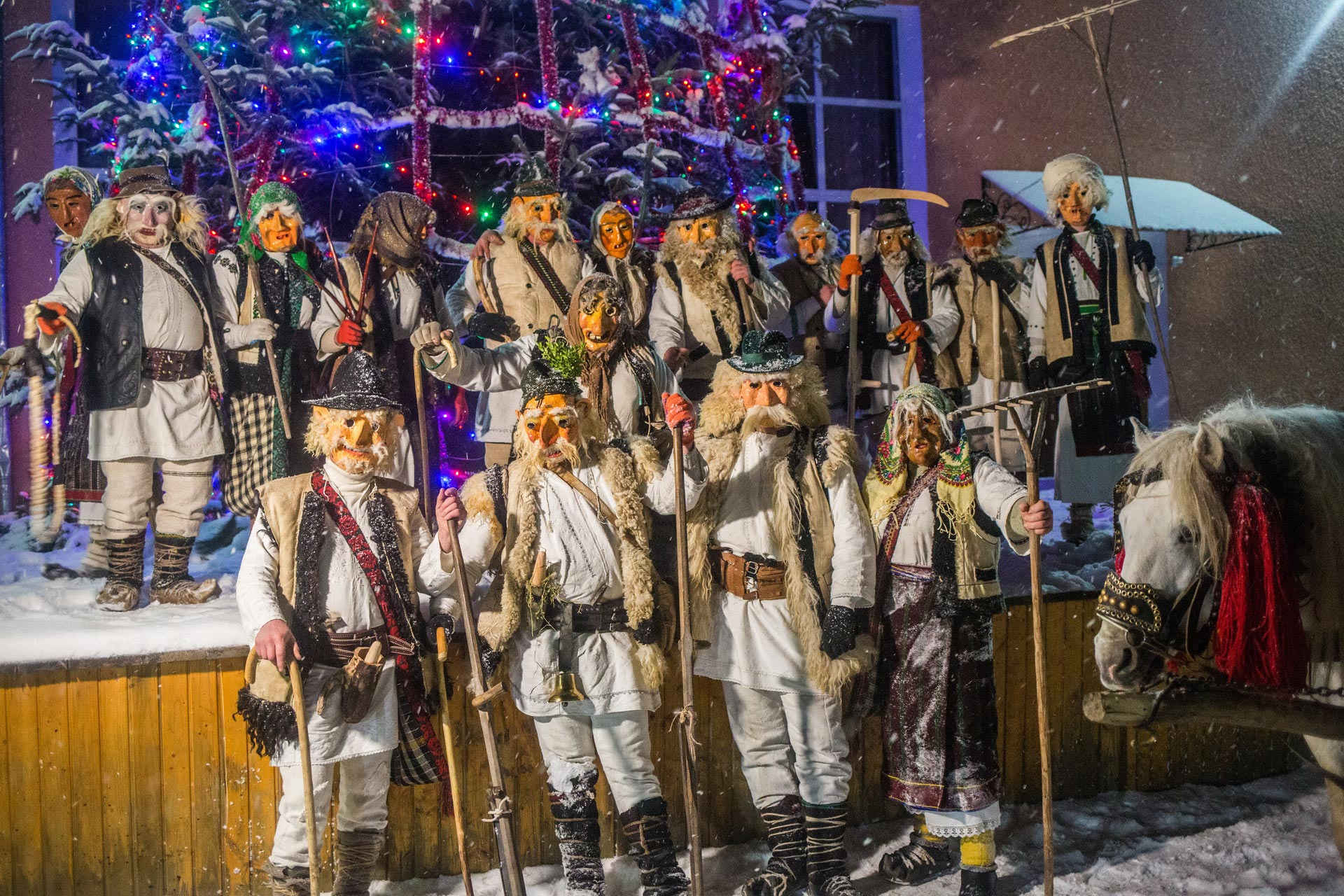
However, the main clients of Ivan’s masks are the participants of his small Malanka team. On the evening of January 13th, they will show up to celebrate Malanka with their own special performance. Malanka is over for Ivan usually around the 15th of January when he goes to Chernivtsi for Malanka Fest, a festival dedicated to Malanka and attended by teams from all over Bukovyna. Sometimes teams from Romania are also invited. For instance, last year they demonstrated their traditions in the town of Suchava, performing under the flags of Ukraine, Romania, and the European Union.
— Ukraine is our country. I was born in Ukraine. I am Romanian. We all are Romanians here. But we respect our traditions, and our nation, and our country. We do not oppose either Ukraine or Romania.
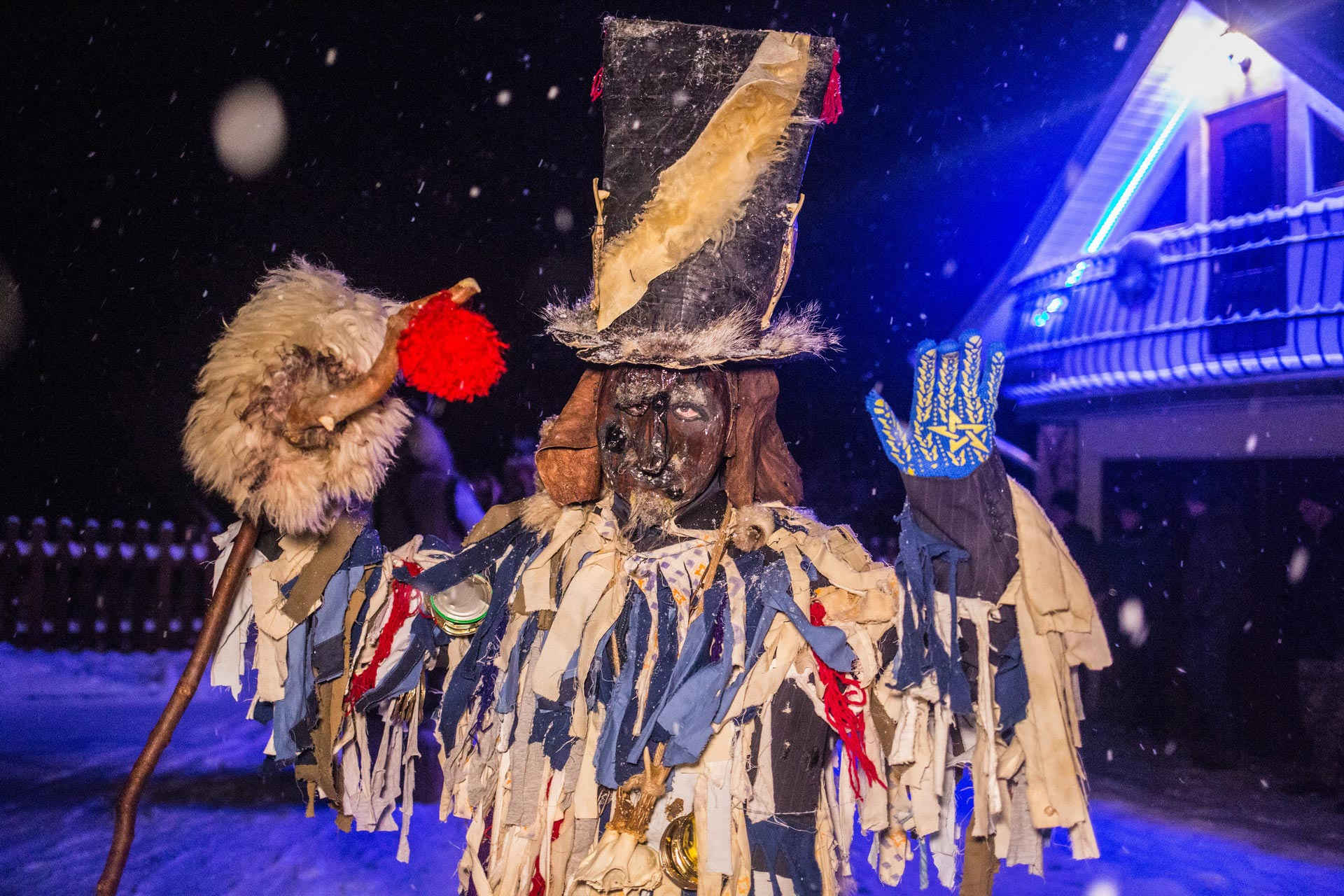
The New Year’s Night
On the 13th of January, little children dressed as Gypsies and Bears, on their own or with their parents, walk from home to home performing their short acts.
In the afternoon, the first costumed people on horses, dressed in furs and traditional costumes, show up on the roads. But it’s only a prelude — the teams are getting together at six o’clock in the evening in different corners of the village Krasnoilsk. The Bears in straw pants have a shot of horilka (Ukrainian strong alcoholic drink), excitedly talking with each other.
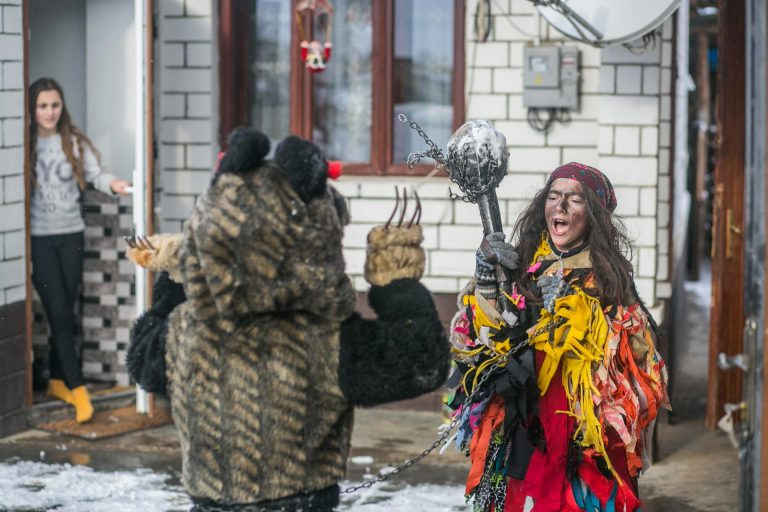
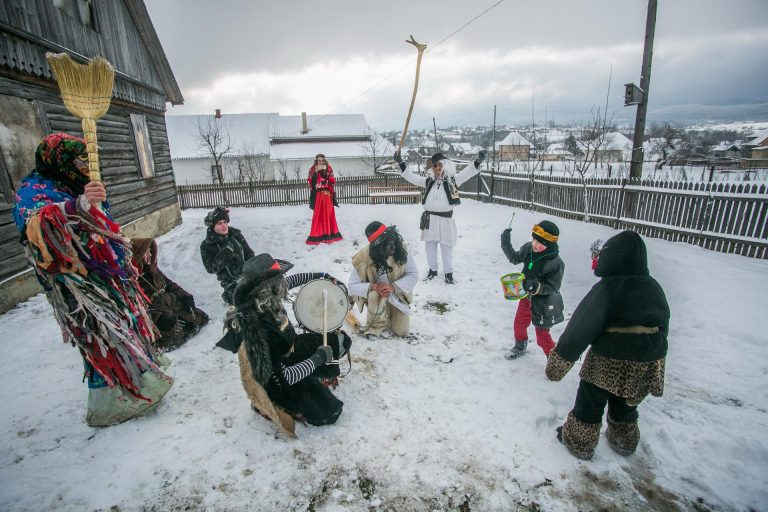
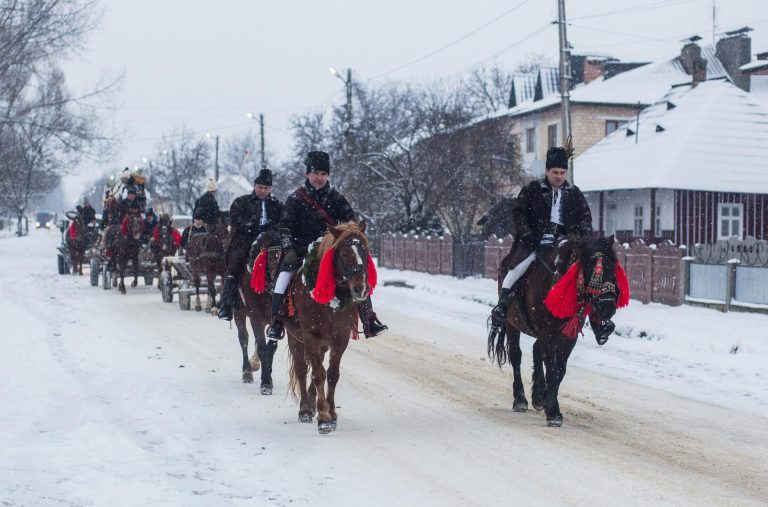
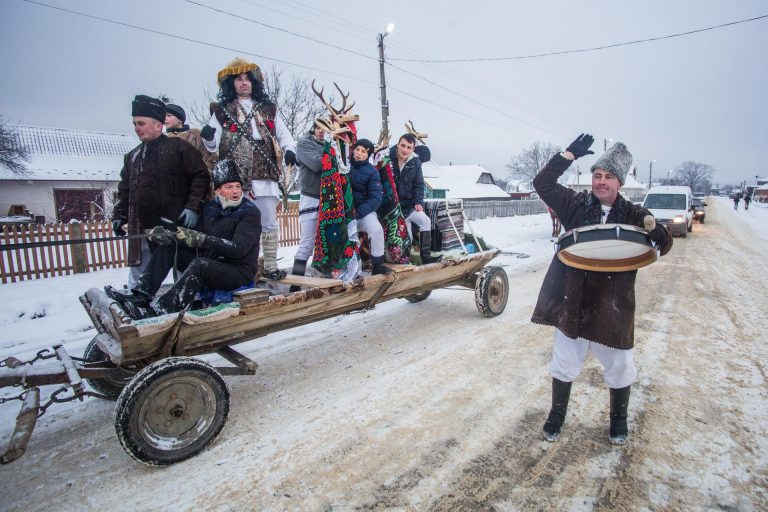
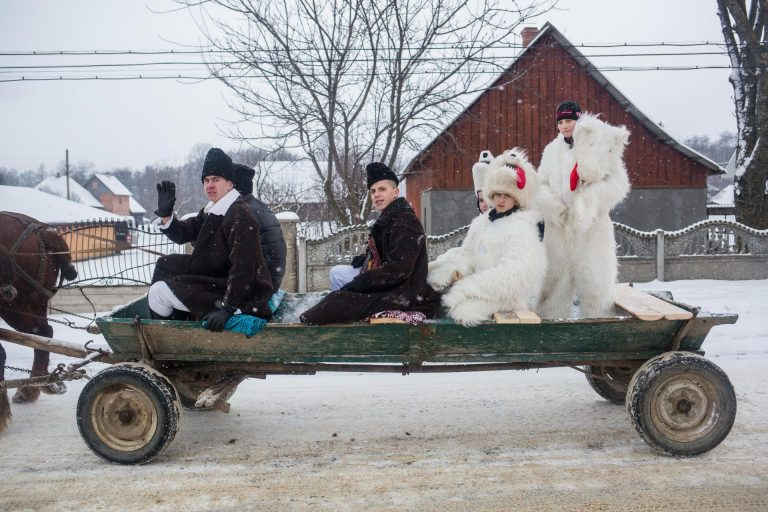
slideshow
The plan for the next 24 hours is planned to the last minute. During the whole night the Malanka teams, counting up to a couple of hundred participants, will walk from house to house in their district, greeting and entertaining everyone. In pre-planned houses, they will stop for a while to take a rest and have a substantial meal so that fatigue doesn’t strike them down later on. During such feasts, the Malanka participants consume quite a lot of alcohol, but those who get too drunk and lose control are sent home at once.
“Malanka walks from house to house to chase evil spirits out. They sing carols so that the New Year starts joyfully,” local people explain, giving the meaning of the performances.
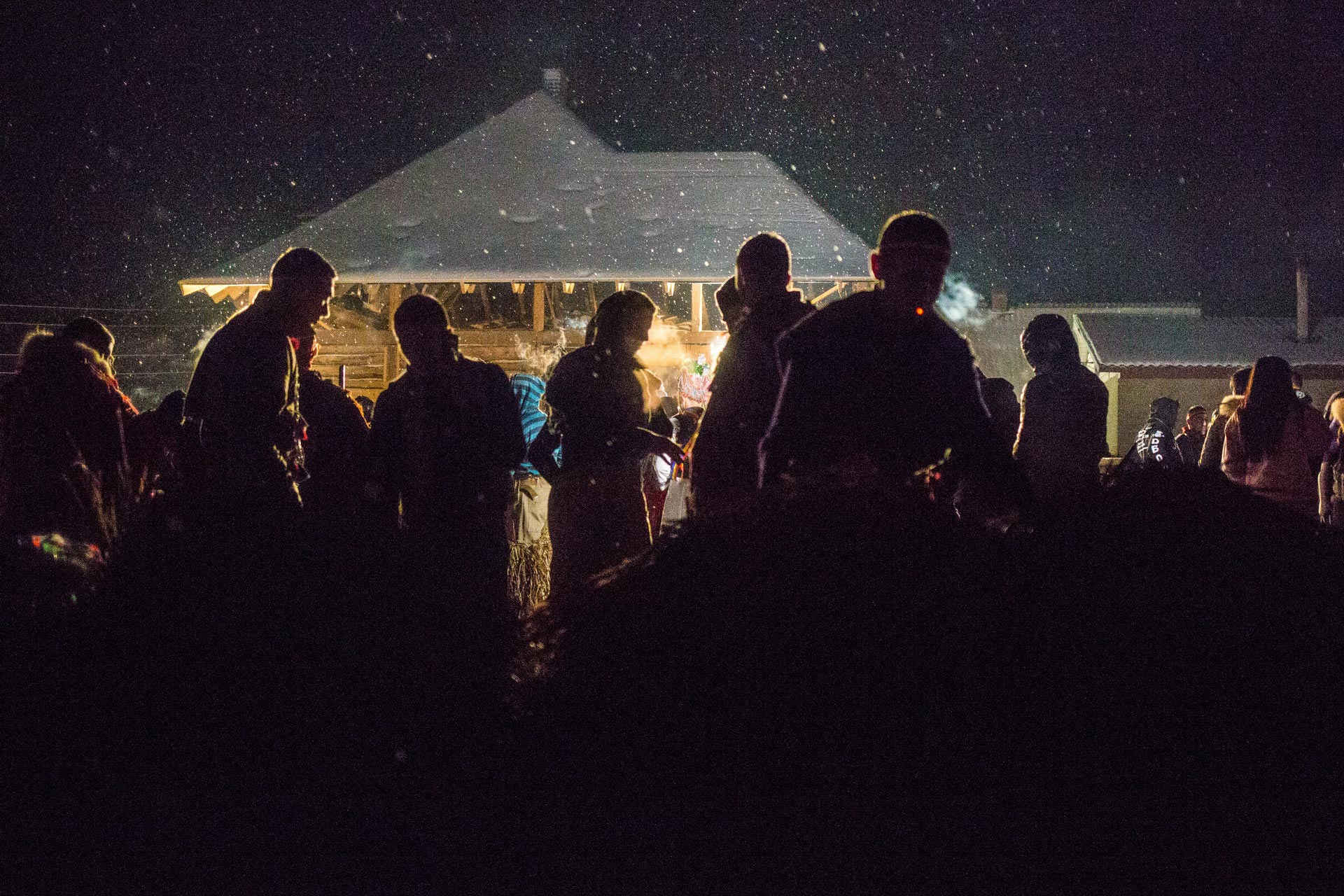
Malanka is loved in Krasnoilsk, and its participants are welcomed to all homes. Teams will not visit a house only if somebody died in the family. In this case, any festivity is inappropriate. Even so, the household inhabitants might come outside to the road and meet the carnival there.
The performance layout is like this: at first, the Komendant greets the hosts and asks their permission to enter their yard. The first to perform are the Grandpa and Grandma, wishing all the best to the hosts. Usually, there are more Grandpas since Krasnoilsk Malanka is a male festival. Next, the Kings and Queens sing and round dance to the sounds of a trumpet. Next to perform are the Jews, Doctors, and Gypsy women with “babies,” while other supportive characters are rummaging around and doing small naughtiness.
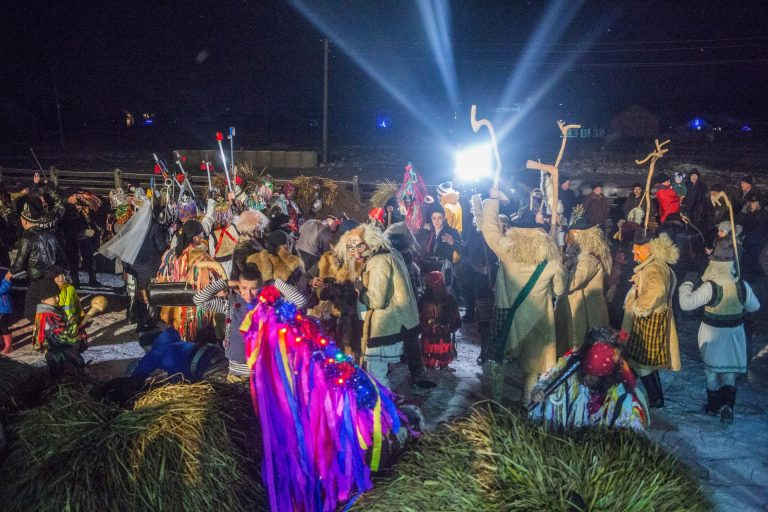
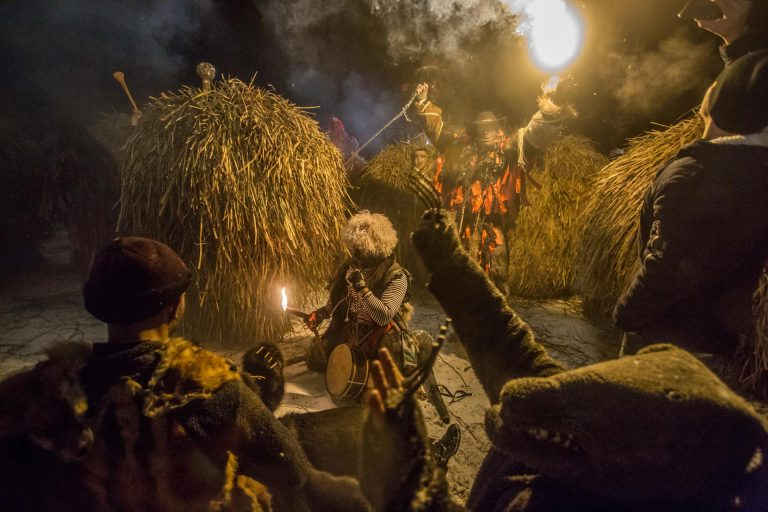
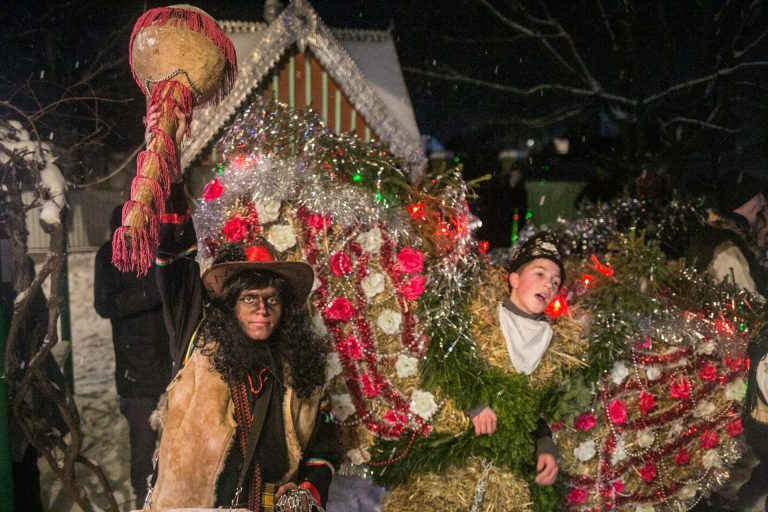
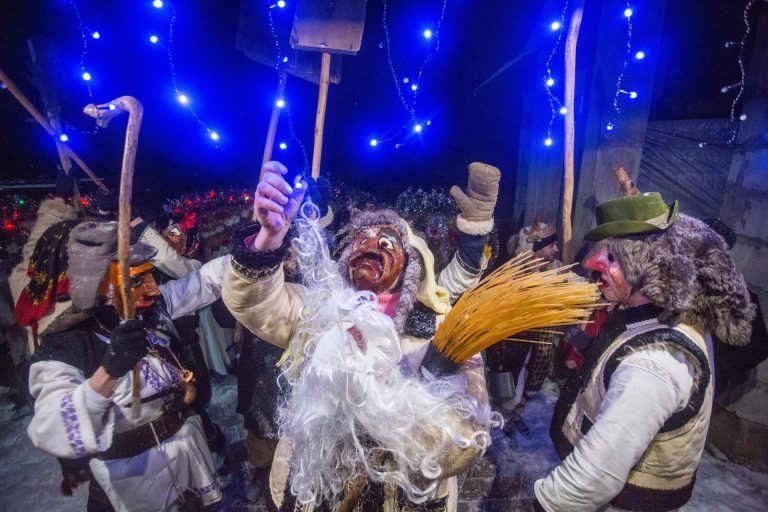
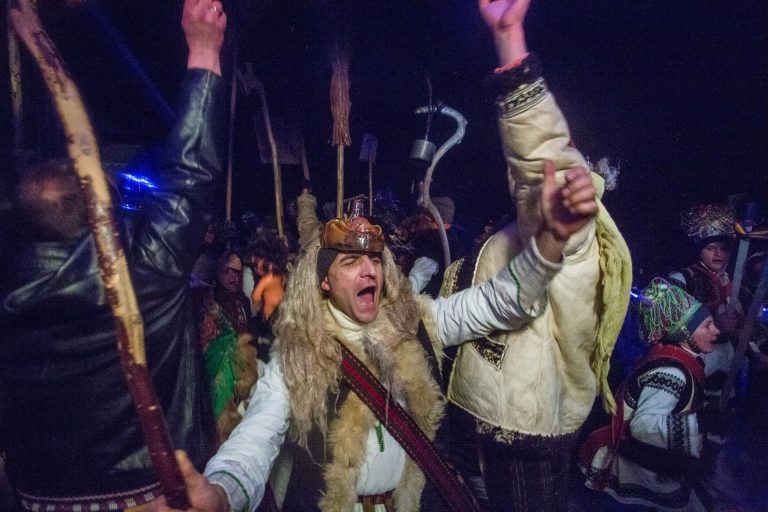
slideshow
The music speeds up, and the dancing gets more expressive until it hits the climax. The Gypsies hit the ground with their grotesque maces, and the Bears start dancing and attacking each other, growling. The fight lasts until the Gypsies calm them down with knives and axes. Then the host of the house gives treats to the team and some money. The Komendant pronounces the amount, and the Malanka team moves on. The whole performance is accompanied by songs and uretura (a text with wishes pronounced in a solemn way).
This is a widespread scenario of the New Year’s performance but there are other variations. For instance, the masks craftsman Ivan and his team perform a masquerade. All team members wear different masks of village people and act out arable traditions.
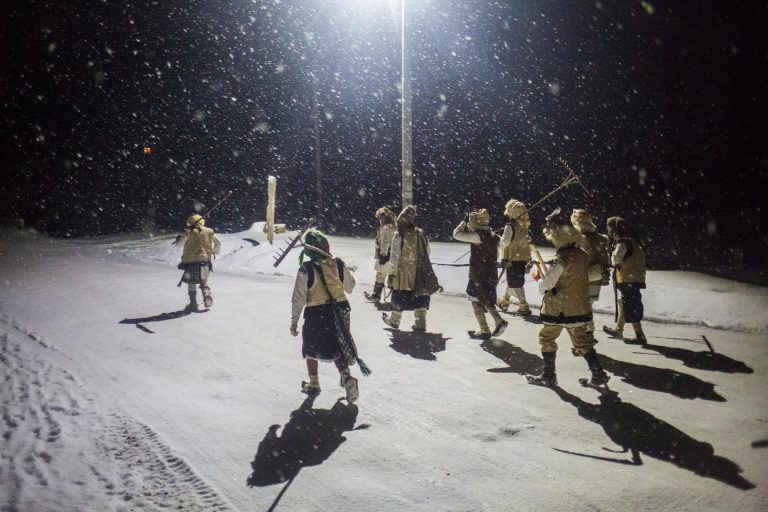
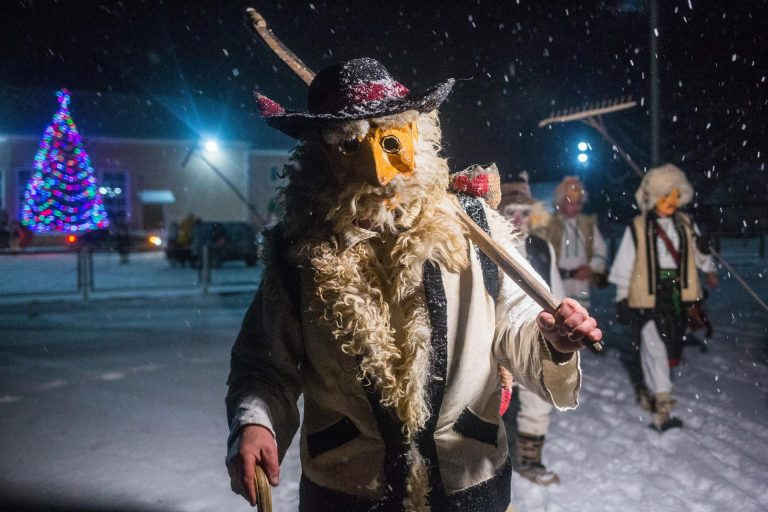
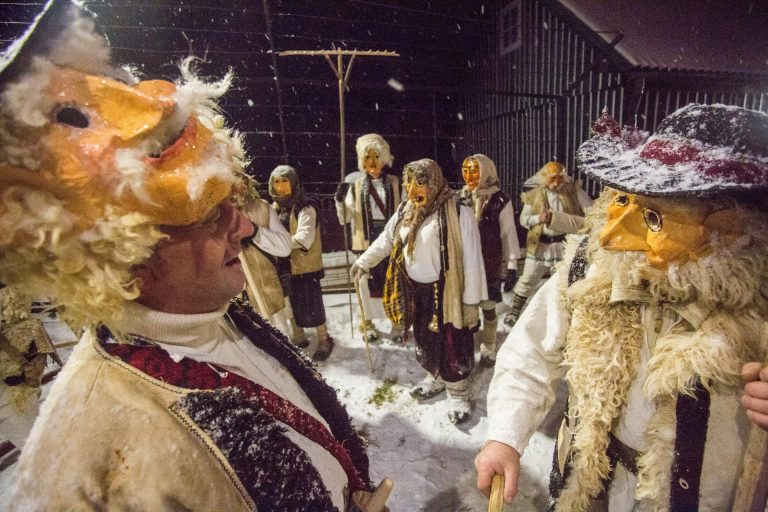
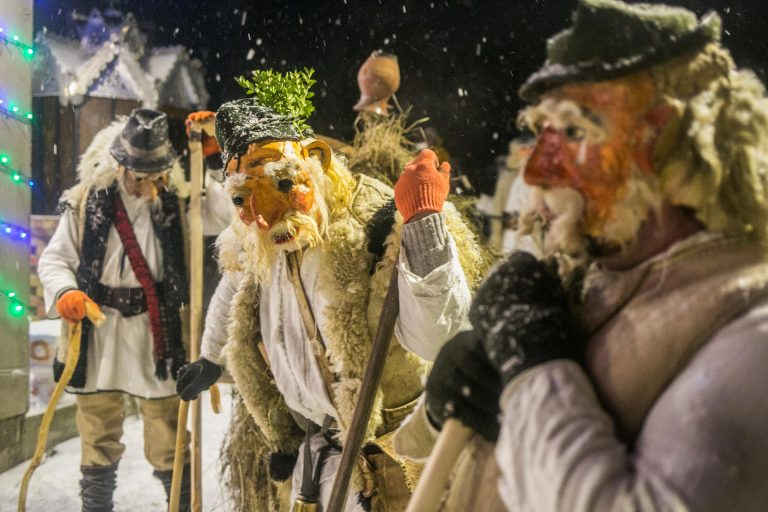
slideshow
— We will act out how people used to scythe and collect hay. You will see. Every year we act out something different. That’s our tradition to show something old, authentic, and not berkut (a police unit) and doctors.
Besides, there is a very old tradition preserved in Krasnoilsk: making the first furrow, or as it’s called in Romanian “plugorash”. The Malanka participants act out making a small furrow in the yard of the household with a plough, imitating the first sowing of the New Year.
Malanka teams walk the village till the early morning. Then they take a break for a couple of hours to nap before the part of the celebration that involves the whole village and is the most popular with tourists.
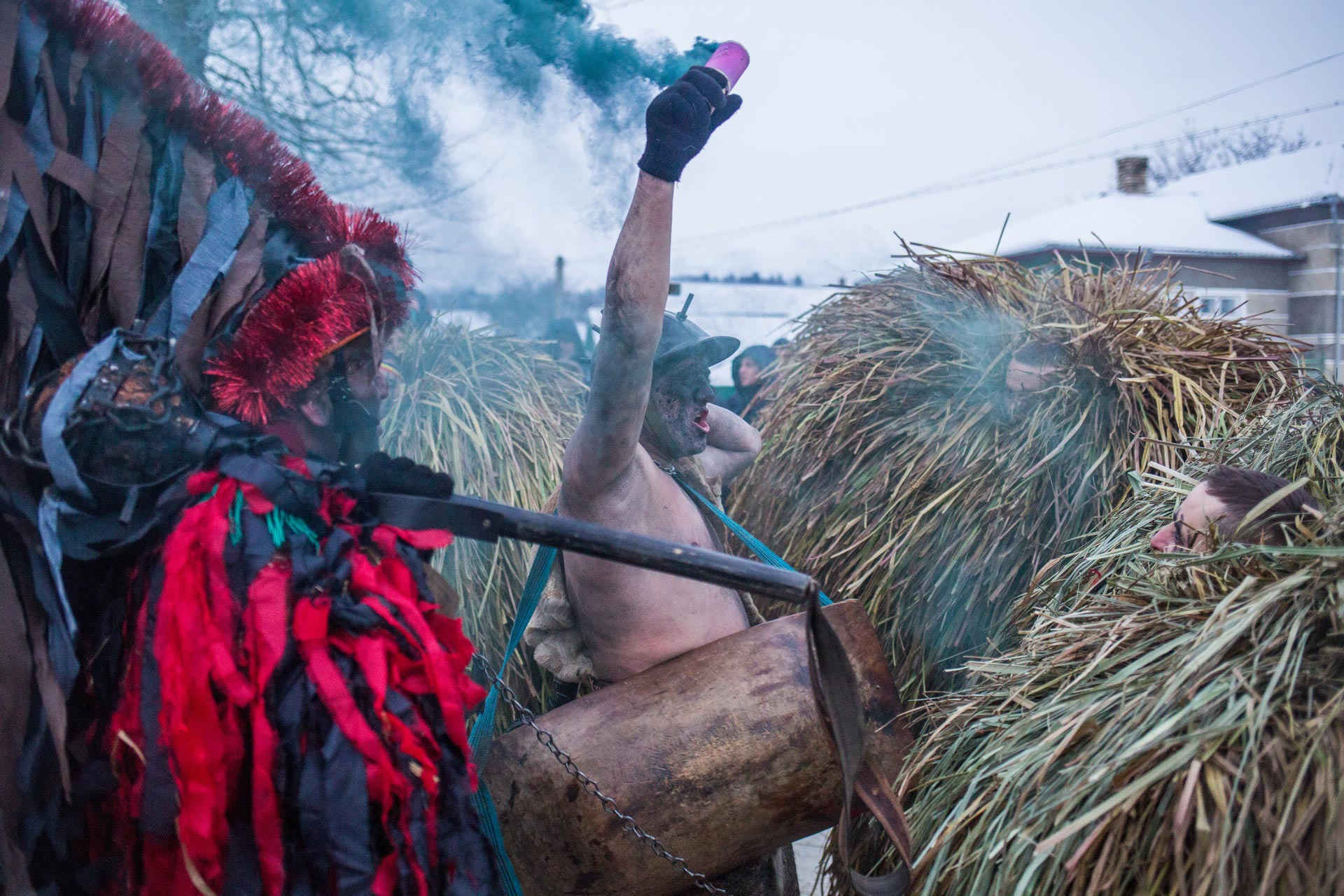
Malanka teams parade
In the morning of the 14th of January, Krasnoilsk resembles a battlefield. At least, that’s the first thought that might come to your mind when you see the border checkpoints at the entrances to the village.
“Last night there were battle actions here,” say the “border patrol officers”. As a reminder: Krasnoilsk is located eight kilometers away from the border with Romania, and until recently there was a real border checkpoint and a fight against smuggling.
Men in masks with fake machine guns stop all types of transport, even carts, searching for “kontrabas” (contraband). They boast with their “catch”, showing a briefcase full of plastic bags with some white powder.
The “border officer” with a knife stops a bus with tourists and gets inside to “search” it, which ends up with everyone donating 10 to 20 UAH to get a permit to enter the village. The Malanka participants joke that they collect this money for the village administration.
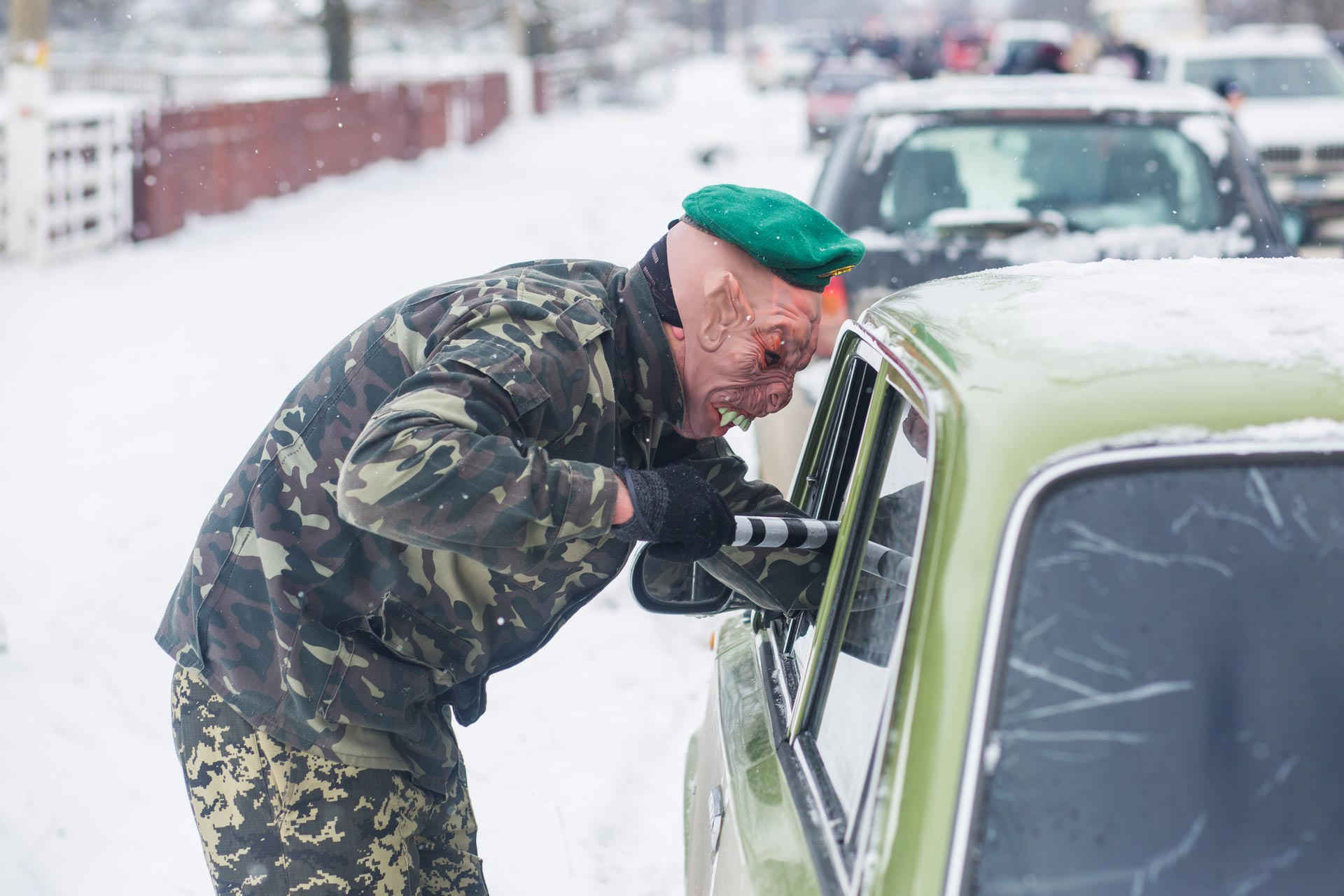
A “bribe” to get into the village is voluntary. When a local woman approaches and tries to get past the checkpoint, they demand five UAH from her, and when she refuses to pay they send her back. All the people that paid get a “ticket” that lets them go through this checkpoint.
The line between real and fictional gets erased, and you can’t always differentiate the cars with real police and doctors from costumed ones.
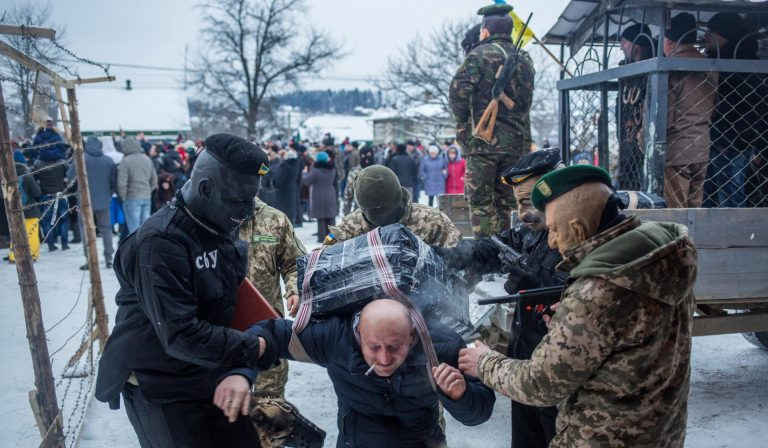
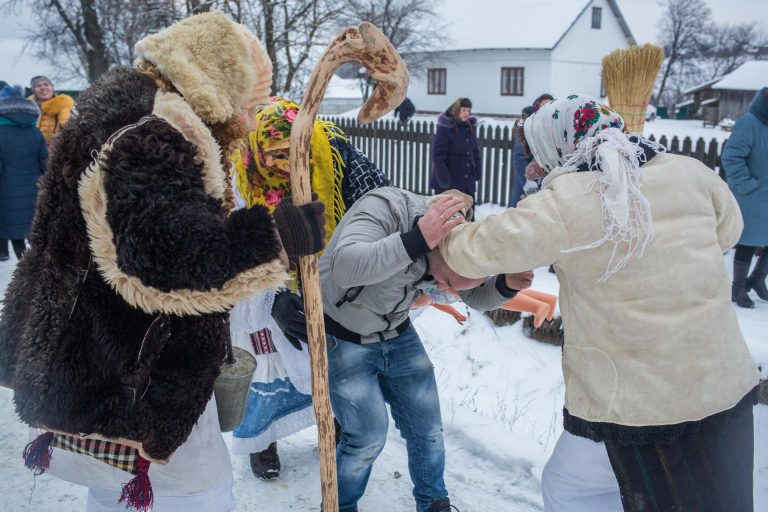
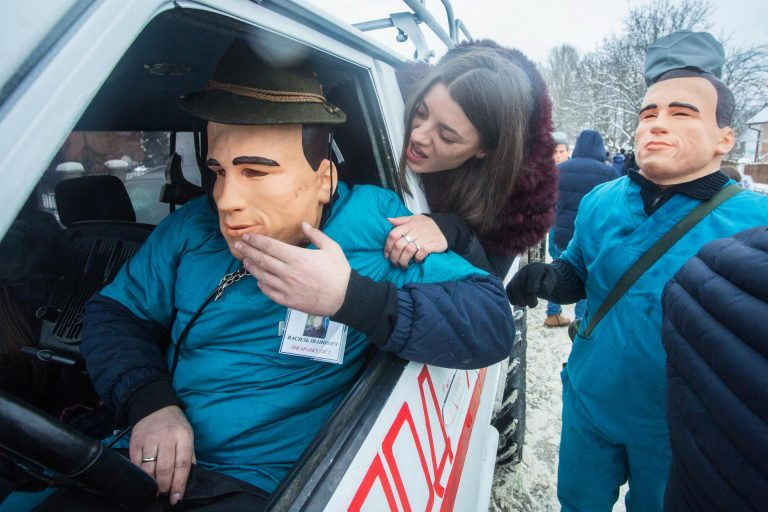
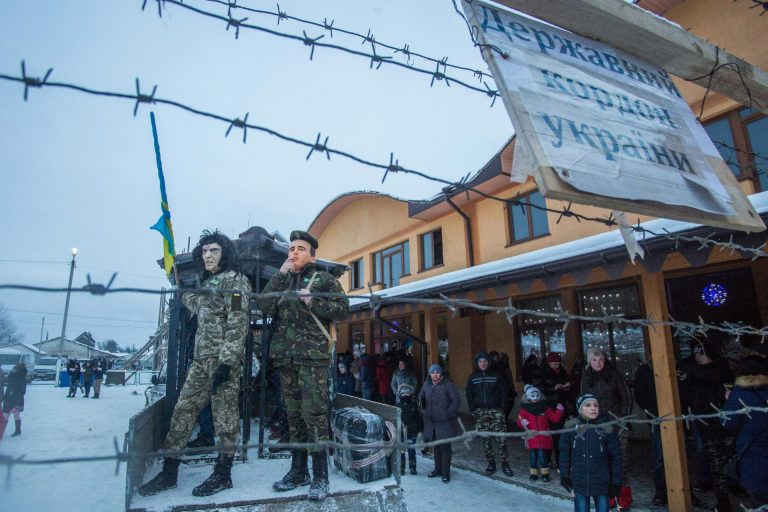
slideshow
In the center of the village, since the early morning a diverse team of characters was being bossy with everyone:the Police and Security Service Officers were detaining passers-by, making them carry heavy boxes and putting them in prison cells until they paid a ransom. The Doctors, wearing Arnold Schwarzenegger masks, tried to drag young people into their fake ambulances with the same aim of getting compensation for their “treatment”. Two Beasts sit a tourist with a camera on a chair and put shaving cream on him, creating a “barbershop” outdoors. The “gangs” of Werewolves and Zombies were roaming back and forth, with one of them wearing a mask of Yeltsyn (the first Russian president) and carrying a briefcase.
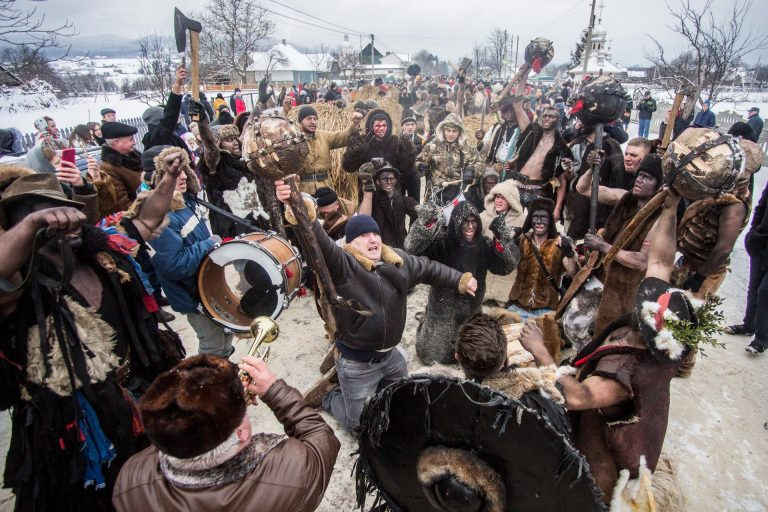
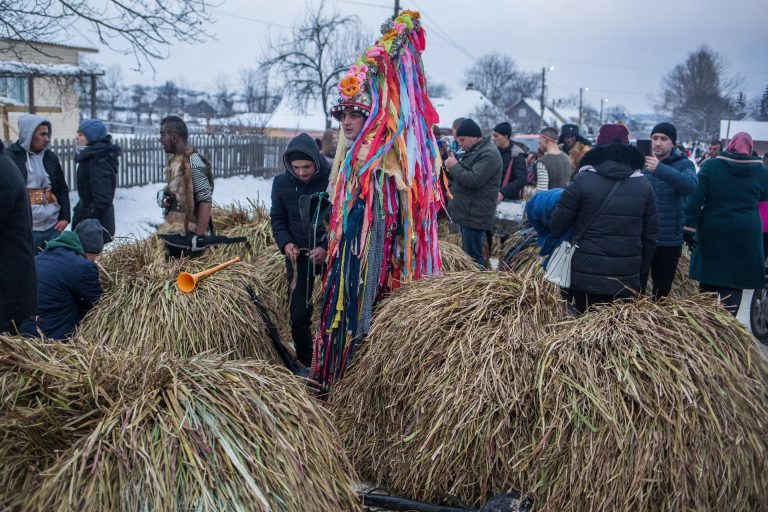
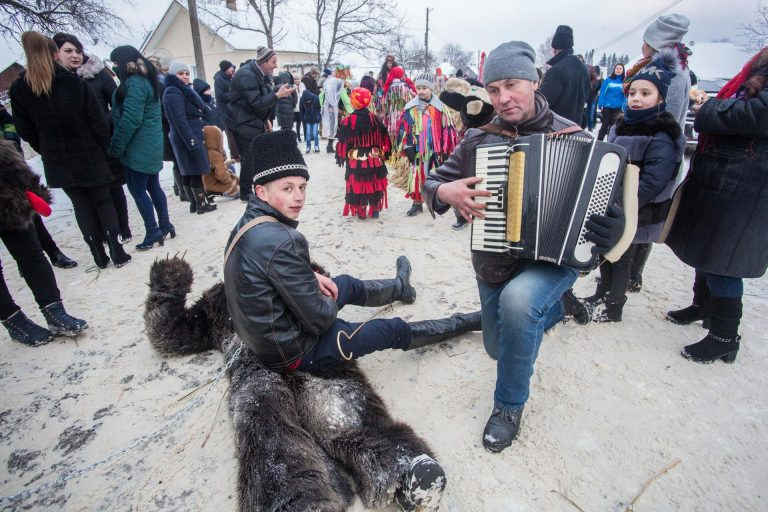
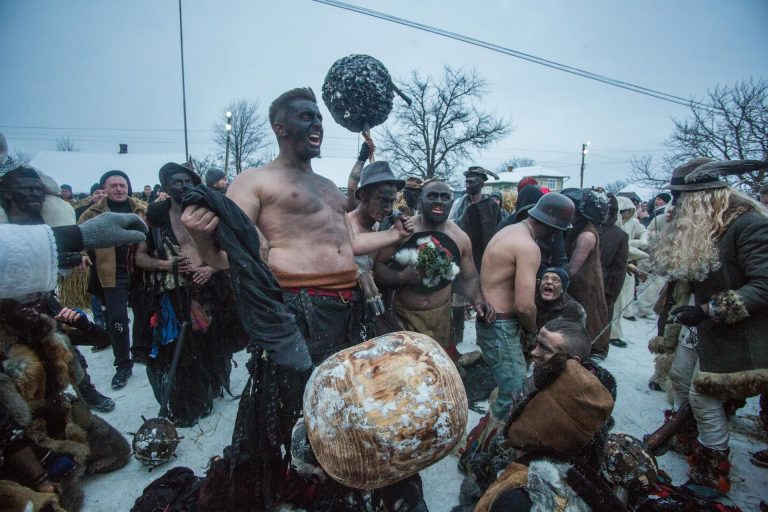
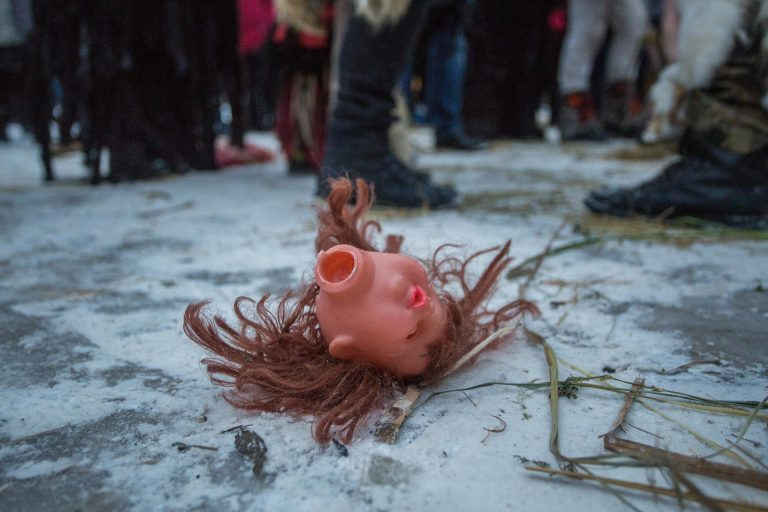
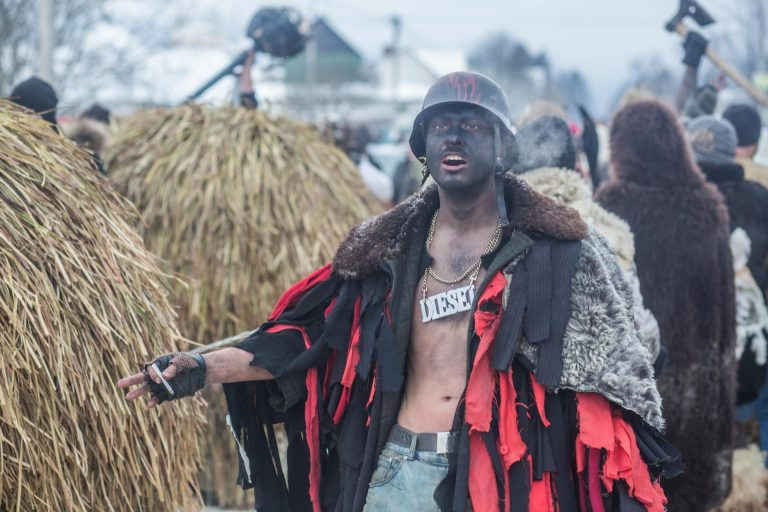
slideshow
At 1 p.m., the Parade of Malanka starts, the event attracting thousands of tourists each year. One by one Malanka teams from all corners of the village enter the main street and give their New Year performance to everyone.
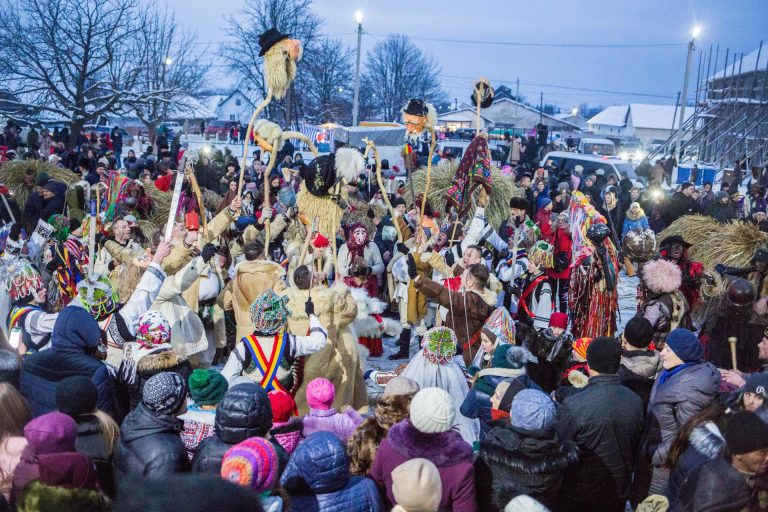
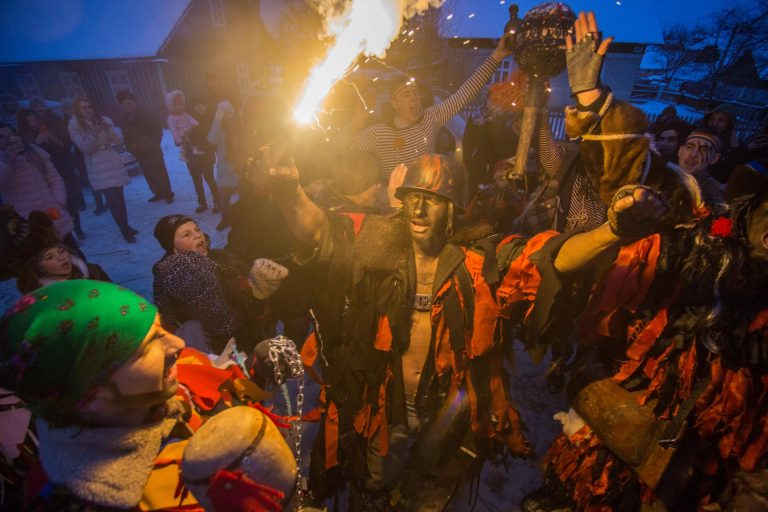
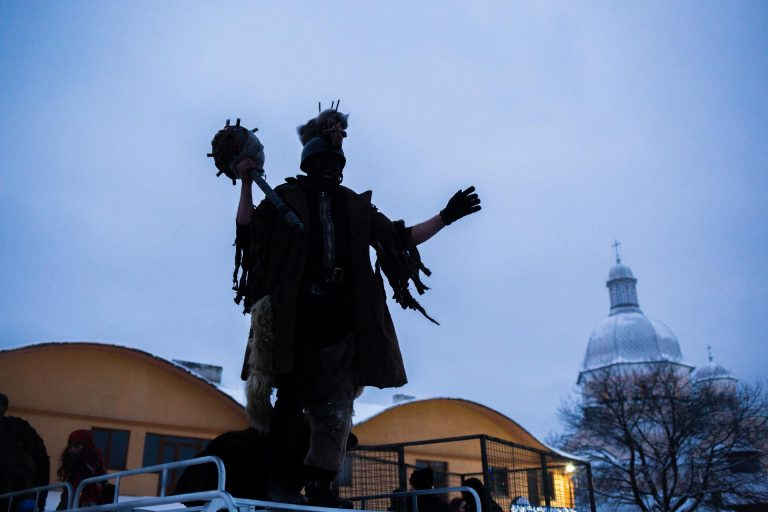
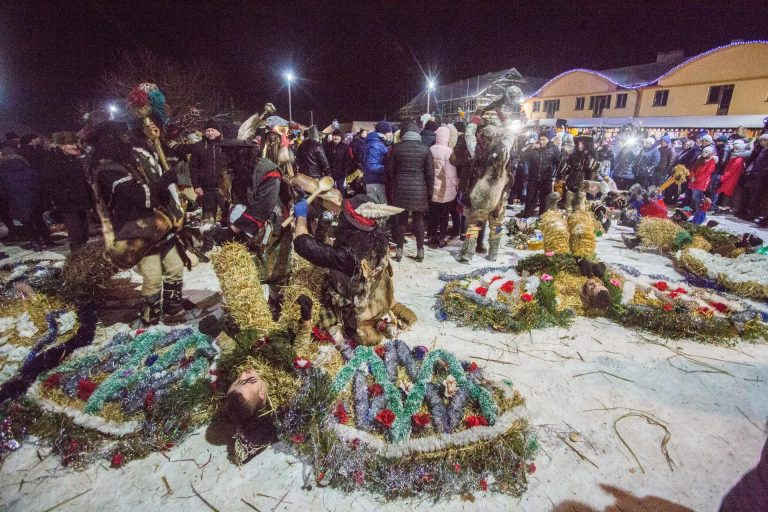
slideshow
The finale of the carnival takes place on the central square, where Malanka teams from every corner come in turns to compete whose performance is more impressive. Dancing, singing, and round dances with fireworks take place. It’s frosty outside but the Malanka participants are so heated by their performances that many of them remove parts of their costumes.
Finally, all the districts have shown their Malanka performances — all the Bears have finished their dances and are lying down on the snow, exhausted. People are slowly leaving, and many of them are heading toward the local grocery store to continue the celebration in an informal circle. The square becomes empty, and it’s hard to believe that just an hour ago the music and singing were whirling here and that you could hardly hear your own voice in this carnival craziness.

Why a carnival?
Local people get offended when somebody calls Krasnoilsk Malanka a carnival. It’s easy to understand: most people associate a carnival with half-naked samba dancers in Brazil, however, a carnival is a very old and very important phenomenon in folk culture.
The term “carnival” dates back to the ancient Roman festival called Saturnalia, which was dedicated to the end of the agricultural season. During that time, people stopped working and went to the streets to celebrate the end of the year and the beginning of a new one. The peak of carnival popularity was in the Middle Ages and very commonly took place before Great Lent. The remains of this event can be observed during Masnytsia period, which is the last week before Great Lent when people cook and serve lots of thin pancakes.

Carnivals anywhere in the world took place according to a special scenario based on old traditions that would turn it into a public event where anyone could become a participant of a performance demonstrated on the city streets. During the carnival period, boundaries were non-existent, and everyone was equal.
Another important feature of a classic carnival is a humorous performance that is based mostly on parodying realities of the past or present life by using the creative masks and grotesque characters that can be recognized by abnormally large body parts, like eyes, bellies, mouths, and so on.

A carnival does not know death. Its highest meaning is to reinstate the continuity and cyclical nature of life. That is why this event is connected to the beginning or the end of the agricultural season and takes place between these two cycles of life.
Today, carnivals in Europe still exist and develop partially due to tourists’ attention and affection toward entertainment of this type. The closest analogs of Krasnoilsk Malanka can be found in Central Europe — Busójárás in Hungary, Kukeri in Bulgaria, Fasching in Germany, Kurentovanje in Slovenia, Zvončari in Croatia, to name a few. All these festivities have a common main character: the Bear or another similar big, hairy creature that is always performed by an unmarried man.

This animal has always been considered to be the king of nature in folk representations of nature, as well as a symbol of fertility, health, and strength. The beginning of spring in Slavic nations was connected with the bear’s awakening from winter hibernation.
The Gypsy was an embodiment of humane power that is able to conquer the power of nature directing it in the necessary direction. That is why during a mock battle between the Bear and the Gypsy during Krasnoilsk Malanka the Gypsy always wins.
Preserving the tradition
“Nobody knows when Malanka had started.” That’s the answer from local people if you ask them when Krasnoilsk Malanka celebrations started.
The latest possible time of this tradition’s origin can be easily established since Krasnoilsk was founded in 1431. If you take a look at characters of Malanka, they likely depict the realities of the Romanian lifestyle dating back to the 17th to19th centuries. Noble people, Jewish-shop owners, peasants, and Gypsies are representatives of social groups that lived in royal Romania.

Back in those times there were also Bears and Gypsies — they even had the special name “ursari” (“ursa” stands for bear in Latin and “urs” denotes a bear in Romanian). Ursari were a nomadic occupational group of Romani people who were involved in bear training. They resided in the Danube principalities of Moldavia and Wallachia. After slavery abolishment for Romani people in the second part of the 19th century, they started actively giving bear performances all over Europe.
It is a fact that in the 19th century Krasnoilsk Malanka somewhat differed. The Bears were not so big and grotesque, and they wore cardboard bear masks instead of karakul hats. The Gypsies did not carry huge maces and did not have so many different characters as today.

The toughest times for Krasnoilsk Malanka started when Western Ukraine became part of the Soviet Union. The event was officially banned, and police went after Malanka participants: they faced arrest for up to 15 days, or, at best, they had to sign a compulsory document stating they would not participate in Malanka ever. Of course, nobody kept the “promise”.
Ivan Tarnovytskyi recalls those times:
— In the Soviet Union police and even border control officers were catching the Bears and burnt down their costumes. They did not let them go to the central street — these were like war actions. But people still went out and performed. Nobody could keep them back.
In order to get an official day off at work on the day of Malanka, men would sign up to donate blood. All the Bear costumes were made unremovable, and the men would be on a bean diet so that they didn’t need to use the toilet too often. In addition, they would carry knives during the celebration so that they could quickly cut open their costumes and flee the police. Removable haystack-like costumes appeared much later and got popular only in a couple corners of Krasnoilsk.

The Police, Border Control Officers, Zombies, and Doctors wearing modern masks are characters that are treated by classic Malanka admirers with irony. However, the appearance of new grotesque characters depicting modern life demonstrates that the Krasnoilsk carnival is developing and attaining new forms.
Even the classic characters of Malanka confirm it is becoming more grotesque from year to year: the Bears’ wings get longer, the Gypsies’ maces get heavier, and their characters acquire more modern features. eEverything that is alive tends to change.

Krasnoilsk Malanka is not an ethnic celebration for Ukraine. It is a Romanian, Central European tradition that is observed in Ukraine. This event can serve as an example of preservation and development of our own traditions. It forms a unique face and image of every nation and can attract thousands of tourists interested in new and unforgettable impressions.

